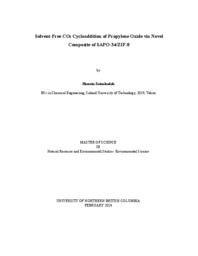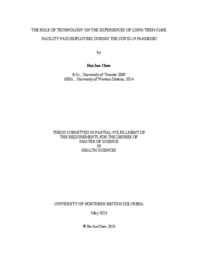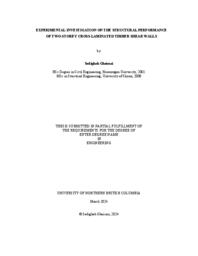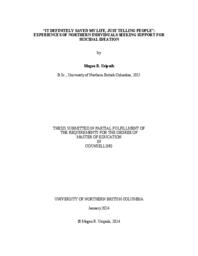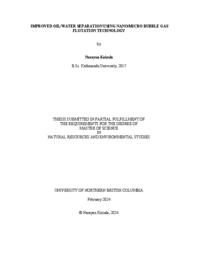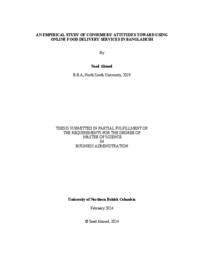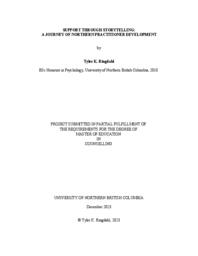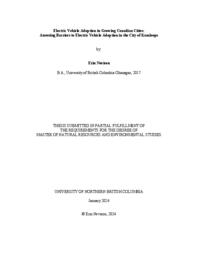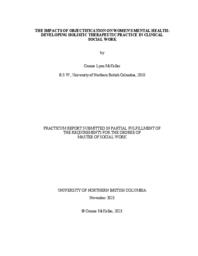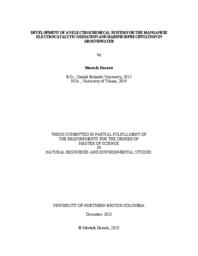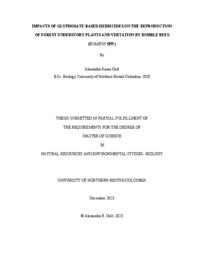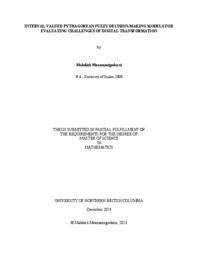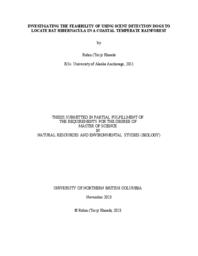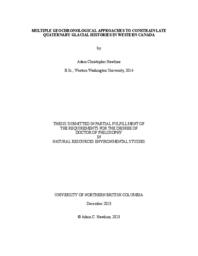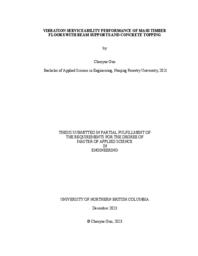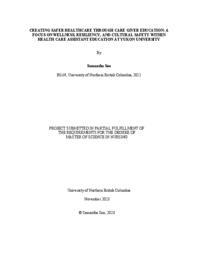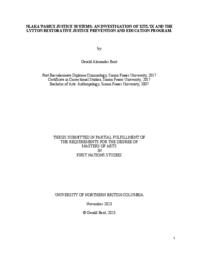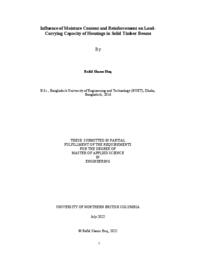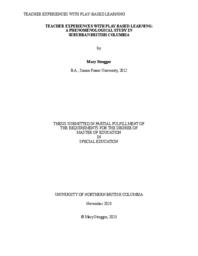University of Northern British Columbia
Related Works
Content type
Digital Document
Description / Synopsis
In this research, ZIF-8/SAPO-34 composites with various wt.% of ZIF-8 and SAPO-34 were prepared and used as catalysts to synthesize cyclic carbonate solventless from CO2 and propylene oxide. Among composites, SAPO-34/ZIF-8 75:25 wt.% (S/Z25) had the highest conversion value of 92.59%, confirmed by 1HNMR analysis. Various physicochemical techniques were used to characterize the optimized composite, including X-ray diffraction (XRD), SEM, FT-IR, and BET. The impact of different reaction parameters such temperature, reaction time, CO2 pressure, and catalyst amount on the catalyst reactivity were studied. The highest conversion value has been obtained at 120 psi, 100 ℃, and 240 min. The conversion value was decreased by 20% when the catalyst loading value was changed from 0.4 to 0.1 g. Additionally, the catalyst's recyclability was confirmed for three runs without any significant changes in conversion. However, it was observed that after five repeated tests of reusability, the conversion percentage value decreased from 92.59% to 88.66%.
Origin Information
Content type
Digital Document
Description / Synopsis
This research focuses on developing environmentally friendly, biodegradable foams as alternatives to traditional petroleum-based materials like polyurethane and expanded polystyrene (EPS). Utilizing pulp and lignin through a cost-effective method, the study optimized factors such as sodium dodecyl sulfate (SDS) concentration, lignin content, and foaming time to achieve desirable mechanical properties and porosity. The box-behnken design identified optimal samples with varied characteristics, including densities from 0.013 g/cm³ to 0.077 g/cm³ and porosities from 95.2% to 99.2%. The introduction of lignin improved foam strength, with compression pressures ranging from 37.5 to 379 kPa. Additionally, the impact of chitosan on porosity, strength, and water resistance was examined. Incorporating 20 wt.% of chitosan enhanced strength by 4% and reduced water absorption by 60%. Over three months, the biodegradable foams displayed significant degradation, introducing them as sustainable alternatives to EPS for diverse applications like packaging.
Origin Information
Content type
Digital Document
Description / Synopsis
The COVID-19 pandemic led to substantial changes in technology use within the long-term care (LTC) sector in Canada. The purpose of this research was to describe the use of technology and its impact on the experiences of LTC staff working in northern British Columbia (B.C.) during the COVID-19 pandemic. A secondary analysis of one-hour semi-structured interviews from 53 participants was conducted. Data was analysed thematically guided by Braun and Clarke’s thematic analysis approach. The experiences of LTC staff varied across disciplines and work roles. LTC staff reported using technologies for inter-department, intra-department or inter-professional communications, as well as to enhance residents’ social interactions. Findings provide insight into the perspectives of LTC staff who had to adopt new technologies and new work processes during COVID-19, thus informing and providing actionable insights for those working in northern B.C.
Origin Information
Content type
Digital Document
Description / Synopsis
Rapid urbanization has led to an increasing demand for sustainable living and working spaces. In response, renewable materials like wood, especially in the form of Cross-laminated timber (CLT), have gained traction due to their sustainability, cost-efficiency, and versatility. However, there remains an insufficiency of experimental tests on multi-storey CLT structures, and the limited studies conducted so far have predominantly used conventional light frame connections. This thesis is centered on evaluating the performance of two-storey CLT shear walls with self-tapping screw (STS) connections, addressing a significant research gap. The research involves experimental tests conducted on two-storey CLT shear walls, with a focus on the effect of the shear connections between floors and tension strap connections as well as the effects of acoustic insulation layers and the presence of perpendicular CLT shear walls on the structural performance. Load-displacement curves showed linear behavior up to the intended lateral displacement, with STS-connected CLT shear walls meeting NBCC drift criteria of 2% height of the structure. Rocking was the primary factor influencing lateral displacement, with tension straps playing an important role. Strengthening shear brackets and adding dead load increased load-carrying capacity by almost 25%. Screw installation angle at tension straps had minimal impact. Also, test results showed that the addition of an acoustic layer had a slight adverse effect, while perpendicular shear walls boosted load-carrying capacities by 15%. In addition, Sliding contributed about 10% to lateral deformations. Panel distortion was minimal, affirming rigid body behavior, and CLT panels acted as rigid diaphragms. This study findings provide valuable insights into the behavior of CLT shear walls, highlighting the importance of appropriate tension strap connections and detailing.
Origin Information
Content type
Digital Document
Description / Synopsis
Suicide in northern British Columbia [BC] is an understudied but prominent health concern. This study aimed to understand the individual experiences of those seeking support for suicidal ideation in northern BC and, specifically, sought to understand what responses are perceived as helpful and not helpful. Using interpretative phenomenological analysis, five semi-structured interviews were conducted, resulting in four main themes found across each interview, each with two sub-themes. These four themes include: 1) Death Avoidance, where participants discussed how death and suicide were avoided, missed, dismissed, and hidden by themselves and others as well as the widespread silence around mental health and suicide in communities; 2) Power and Powerlessness, which describes the power that suicide held over the participants and their attempts at reclaiming some of that power; 3) Meaning and Meaninglessness, which explores the search for purpose and meaning each participant underwent; and 4) Connection and Safety, which discusses the complex interactions between connection and disconnection, and the ways that felt sense of safety, or the lack of, impacted connection and suicide. This study supports existing literature that describes the importance of safe and validating connections that allow for options, choice, and exploration of meaning. Moving forward, collaborating with individuals considering suicide in a trauma-informed manner that emphasizes respect, validation, power, and meaning is recommended.
Origin Information
Content type
Digital Document
Description / Synopsis
This research investigated the performance of nanobubble and microbubble (NB/MB) gas flotation technology in treating oily wastewater generated after oil spill response operations. The study comprised three distinct sets of experiments. In the initial set of experiments, experiments were conducted to examine the impact of reactor configuration on the NB/MB gas flotation process. Three different reactor configurations were employed, varying in height-to-diameter ratios of 10, 20, and 30. The results indicated that reactor configuration slightly affected system performance, with gradual improvement observed as the height-to-diameter ratio increased. Following the analysis of reactor configuration, response surface methodology (RSM) was utilized to design experiments focusing on three key factors: initial oil concentration, gravity settling time and flotation time. The purpose was to analyze their impacts on oil/water separation performance and the interactions among these factors. Additionally, introducing gravity separation prior to NB/MB gas flotation aimed to assess whether allowing collected oily wastewater to settle in containers on barges would accelerate oil/water separation compared to exclusively relying on NB/MB gas flotation without gravity settling. The results from the experiment demonstrated a strong agreement between the predicted and experimental data for oil/water separation efficiency, as indicated by a high R2 value of 0.99 and an adjusted R2 value of 0.98. The predicted R² value was 0.91. Subsequently, additional single-factor experiments were conducted to determine the maximum oil/water separation efficiency. The findings revealed that an oil/water separation efficiency of 98.8% was achieved under the optimum experimental condition with the initial oil concentration of 1995 mg/L, the gravity settling time of 45 minutes and the flotation time of 38 minutes. Likewise, a second set of separate experiments was conducted after the RSM experiments to study how different levels of oil weathering affect the oil/water separation efficiency using MB and NB gas flotation. The results indicated no significant difference in oil separation efficiency between fresh and weathered oil samples. Furthermore, a third set of experiments was carried out at a pilot scale to scale up the technology and assess its feasibility. The experiments were conducted at a pilot scale (75 L). The results demonstrated a remarkable oil/water separation efficiency of 92% within one hour, surpassing gravity separation, which achieved only 4.62% over the same duration. Similarly, combining NB/MB gas flotation with adsorption achieved nearly 100% oil/water separation efficiency. Thus, the result from the experiment concludes that NB/MB gas flotation is efficient in separating oily wastewater generated after oil spills. The successful implementation of NB/MB gas flotation technology in offshore oil spill response vessels offers a promising solution with exceptional separation performance and scalability, with a minimal environmental impact, as it is a chemical-free technology.
Origin Information
Content type
Digital Document
Description / Synopsis
The online food delivery service industry has the potential to be one of the biggest industries in Bangladesh and contribute significantly to the economy. Technological advancement has powered the potential expansion of online food delivery services in Bangladesh. While there has been some recent research on the shift in Bangladeshi consumers' food consumption habits, there still needs to be more research on the online food delivery service industry. Noticeably, online food delivery services are only available to people living in large cities or suburban areas in Bangladesh. Rural populations have limited access to these services. The reputation of the delivery services is sometimes adversely affected by inconsistent customer service, which includes problems with order accuracy, poor user interface, and lack of responsiveness. Therefore, this study analyzes the consumers' attitudes toward using online food delivery services in Bangladesh. This study revisited the theory of the technology acceptance model (TAM) theory by retaining user motivation. According to the TAM theory, user motivation is considered as perceived ease of use and perceived usefulness, whereas in this study, perceived usefulness has been simplified by two independent variables: various food choices and time-saving orientation. Thus, the three original constructs from the TAM theory included in this study are attitudes toward using the technology, perceived ease of use, and perceived usefulness. The core objective of the study is to determine the influence of perceived ease of use, various food choices, and time-saving orientation on the consumers' attitudes toward using online food delivery services in Bangladesh. Secondly, the study examines the moderating role of the 'online shopping experience' on the user's motivation in Bangladesh.
Origin Information
Content type
Digital Document
Description / Synopsis
In the challenging mental health landscape of Northern British Columbia, a tale of connection unfolds - a narrative woven into the fabric of rural life that binds practitioners in a shared struggle for support. The complexities of care within this region, marked by the culmination of multiple health crises, have stressed the importance of centralizing practitioners as the protagonists within this story of social wellness. A need for meaningful clinical support has arguably never been greater, rising in response to the contextual needs of an often-isolated workforce, generally lacking specialized training in counselling processes. This story delves into the complex, fragile relationships that compose a Northern system of care, shaped by a unique socio-cultural climate and held in place by a tenuous thread. While acknowledging the scarcity of empirical evidence on the counselling experience in rural settings, this narrative draws on the value of engaging Northern practitioners’ voices in shifting supportive service delivery. In the quest for professional growth and competency, clinical supervision has materialized as a crucial collaborator in supporting professional practice, recognizing the invaluable position of developmental location in bridging the theory-to-practice divide. The following project seeks to redress these disconcerting discrepancies by providing an avenue to access and interpret helpers’ experiences, facilitating ongoing growth and development as conceptualized within an integrated developmental framework. Stories unfold as particularly salient means to aid this process of exploring practitioners’ developmental trajectories, fostering understanding, validating experiences, and unravelling complex elements of practice. This resource attempts to tap into this profound power of story to aid clinical supervisors in empowering practitioners, conceptualizing the process, and assisting helpers in navigating their nuanced narratives as they embark upon their journey of self-discovery in hopes of helping others.
Origin Information
Content type
Digital Document
Description / Synopsis
Greenhouse gas emissions from transportation are a significant contributor to climate change. An effective method of reducing these transportation emissions is to electrify transportation. Local governments are creating electric vehicle policies to increase electric vehicle adoption in their communities. The City of Kamloops released their EV Strategy to encourage local electric vehicle uptake in 2020 but encountered barriers to local electric vehicle adoption such as a lack of charging infrastructure, a hesitancy to new technology, and the high prices of EVs. There is no significant research on EV adoption and barriers within a smaller city, regional hub, or Canadian context. To address this, I conducted a content analysis, literature review, and key informant interviews with six stakeholder groups in Kamloops to assess the perceived barriers to EV adoption. My research compares the perceived barriers within the context of Kamloops and provides policy solutions to the City of Kamloops to overcome these barriers and reduce transportation emissions. The City should continue to prioritize EV adoption through public education campaigns, encourage the building of charging stations, and focus on densification for an overall reduction of emissions and to provide convenient places for EV drivers to charge their vehicles.
Origin Information
Content type
Digital Document
Description / Synopsis
The aim of this dissertation is to investigate and quantify biophysical diversity on landslides in the boreal forest of the Peace River Region of northern British Columbia (BC), sampling three landslides that occurred in the last 50 years. Landslides are increasing in the boreal forest, likely driven by climate changes such as increased precipitation and permafrost thaw, and as a derivative of large wildfires. An understanding of ecosystem recovery on landslides is important for conservation and management purposes. Several studies have been done in southern parts of the world to elucidate processes of landslide recovery. However, few studies have addressed landslide recovery in northern climates, and little is known about the biophysical diversity of landslides in this region. This research investigates whether landslides are more biophysically diverse than the surrounding relatively undisturbed terrain, and whether microsite variables or geomorphic diversity are predictors of plant community diversity. Using a series of field sampling campaigns and GIS (geographic information system) mapping exercises, I show that landslides are more biophysically diverse than the surrounding terrain in some respects, while the surrounding undisturbed terrain is more diverse in other aspects. The age and size of landslides also appear to influence diversity. Microsite diversity does not necessarily predict plant diversity. The research highlights the role of invasive plant species in slope stabilisation and plant community makeup. I also show that landslide ponds are disproportionately concentrated on rotational landslides, and that most ponds on landslides occur in the body and toe. I note post-slide modifications such as drainage of landslide ponds and lowering of landslide ridges, but many geomorphic features are expected to endure for decades to millennia. Overall, the research shows that vegetation recovery is complex and may take decades to fully manifest. This study contributes knowledge about plant community and site diversity on landslides by providing quantitative data and comparing those traits with those found on surrounding terrain. These findings can be used as guidance when identifying conservation and management practices for ecological restoration of disturbed slopes.
Origin Information
Content type
Digital Document
Description / Synopsis
no abstract available
Origin Information
Content type
Digital Document
Description / Synopsis
Acetylcholinesterase is a hydrolase enzyme known for its major role in neurotransmission regulation by breaking down the neurotransmitter acetylcholine at the synapse after every electrochemical signal is successfully relayed between two adjacent neurons. In a healthy human brain, it retains itself on the extracellular surface of neurons, concordantly paints up an artistic beautiful web of an intricate neural network upon staining. However, in an aging human brain experiencing neurodegeneration, the network collapses into plaques that are neurotoxic to the brain. At the center of these individual plaques are heavily aggregated amyloid-beta peptides and fibers enveloping the neurons. This is most often one of the specific traits of Alzheimer’s and Parkinson’s disease, two most common neurodegenerative diseases. Many studies have provided experimental evidences of stable co-localization and fiber growth promotion existing between the amyloid-beta peptides and acetylcholinesterase. Nevertheless, the specific chemistry and mechanism of how the relationship between the amyloid-beta peptides and acetylcholinesterase is formed and maintained, still remains tentative to date. Most neurodegenerative diseases remain incurable, and most of the available medical treatments focus on alleviating the symptoms and mitigating the disease progression, for instance through the use of acetylcholinesterase inhibitors. But with drawbacks related to treatment effectiveness and undesirable side effects of the current available acetylcholinesterase inhibitors, the continued search for more effective acetylcholinesterase inhibitors has never ceased. The objectives of this in vitro study were to examine four small molecules and twenty-one mushroom extracts for their ability to inhibit acetylcholinesterase activity. To perform the screen, an enzyme assay using Ellman’s reagent DTNB was used. The assay utilizes thiocholine produced from the hydrolysis of acetylthiocholine by acetylcholinesterase to reduce DTNB into TNB2-, a colorimetric product that can be used to monitor the changes in the acetylcholinesterase activity level in the presence or absence of inhibitors. Using the established acetylcholinesterase assay, none of the four small molecules showed any inhibitory effect on acetylcholinesterase activity. On the contrary, eight of the mushroom extracts were found to inhibit the acetylcholinesterase activity. These eight extracts were prepared from five mushroom species that have not been extensively researched nor reported for acetylcholinesterase inhibition. Surprisingly, for the remaining thirteen mushroom extracts that did not show inhibition, they were found to enhance the acetylcholinesterase activity. Albeit the unexpected irrelevance to the focus of the study, these thirteen extracts could be useful as biological tools in the general research of regeneration, as acetylcholinesterase has been reported to act as a mediator promoting cell proliferation and regeneration.
Origin Information
Content type
Digital Document
Description / Synopsis
Manganese is one of the most occurring heavy metals in the source and drinking water of rural and remote communities in Canada. The removal of manganese from groundwater was explored by designing a biochar-assisted electrochemical technology as a small-scale and chemical-free method. Electrocatalytic oxidation of manganese was acquired while utilizing wood residue biochar as a coating layer on the surface of activated carbon felt anode. The biochar-coated anode showed enhanced conductivity and surface area, consequently facilitating the electron exchange and manganese removal efficiency. Manganese initial concentration, current intensity, pH, and time were considered the main variables and their effect on the removal efficiency of manganese from groundwater was investigated. Current had the most influence on removal efficiency, as evidenced by the fact that no manganese removal occurred at zero current and the removal efficiency was increased by enhancing current from 25 to 75 mA. With the Mn initial concentration of 2 mg/L, current of 75 mA, pH 9, 97.5 % manganese removal efficiency was acquired, which helped to reduce the contaminant concentration under the maximum acceptable concentration. The results demonstrated a well-fitted pseudo-first-order model with a rate constant of 0.0411 min-1 for electrocatalytic oxidation. Real groundwater of Lheidli T'enneh community in Northern BC was employed to evaluate the impacts of co-existing ions on the manganese removal performance. The results confirmed that not only did the use of real groundwater have no detrimental impact on the system’s efficiency, but also the system was able to decrease the high hardness of 268.2 mg CaCO3/L in the groundwater to 72.2 mg CaCO3/L suitable for drinking purposes. Investigation of the manganese removal mechanisms indicated that various species, such as hydroxide ions, sulfate, and hydroxide radicals can play key roles in transferring or removing manganese from groundwater by oxidation and precipitation pathways. The formation of a black powder precipitated on the anode surface and in the cell after treatment proved that oxidation of manganese takes place in the system. Furthermore, the evolution of pH after 90 minutes of reaction further confirmed the presence of hydroxide ions in the system. Overall, the designed system achieved a significant performance in removing manganese and hardness from groundwater while utilizing biochar as a waste and cost-effective material.
Origin Information
Content type
Digital Document
Description / Synopsis
Glyphosate is the active ingredient in many common broad-spectrum herbicides used in forestry operations to reduce the presence of unwanted, competitive plant species. As a result of aerial applications, non-target forest understory plants receive a sublethal dose of glyphosate-based herbicides (GBH) and develop abnormalities such as changes in reproductive morphology. Glyphosate inhibits the enzyme 5-enolpyruvylshikimate-3-phosphate synthase (EPSPS) of the shikimate pathway which produces the crucial aromatic amino acids for plant growth and other biochemical processes. There is very limited information on the long-term impacts of GBH on forest understory plant reproduction, fruit production, and vegetation production. Additionally, there are limited resources that discuss the impacts of GBH on the detection and visitation by bumble bees (Bombus spp.). The objectives of this research were to: 1) quantify glyphosate residues present in Chamaenerion angustifolium flowers and in samples of Bombus spp. found in areas treated with GBH; 2) quantify and compare stamen fluorescence of C. angustifolium (fireweed) flowers from GBH treated and untreated areas in operational forestry settings; 3) quantify the abundance and occurrence of different Bombus spp. in cutblocks one- and two-years post application compared to control sites; 4) quantify and compare the visitation of C. angustifolium by Bombus spp. in glyphosate-based herbicides treated and untreated plants; and 5) quantify and compare pollen viability, leaf-out, and fruit production in a variety of important food-producing forest plants in glyphosate-based herbicide treated and untreated sites in operational settings. I found that the amount of glyphosate residue present in floral tissues remained similar between one- and two-years post treatment. I also found that glyphosate-based herbicides have an impact on the fluorescence of male reproductive structures of forest understory plants. There was a reduction in the fluorescence emission of blue spectral wavelengths of anthers and pollen due to glyphosate-based herbicide treatment could lead to a reduction in detection and visitation by bumble bees as the blue photoreceptor in their compound eyes will be less likely to detect a flower for the bee to be drawn to it. Additionally, the increase in hue and saturation indicates that the presentation of the dominant wavelength present may no longer be the blue spectral wavelength. My findings indicate that glyphosate-based herbicides do not have an impact on the amount of time an individual bumble bee spends foraging on a flower. Glyphosate treatment influences floral characteristics related to bumble bee detection of flowers during foraging. This affects the number of bees present, but glyphosate-based herbicides do not impact how long an individual bumble bee visits a flower nor foraging effort once they are on a flower. The reduction in pollen viability seen in C. angustifolium one-year post-application is similar to pollen viability seen in control samples by year two after glyphosate-based herbicide applications, indicating that GBH initially have a large impact on pollen quality but there is a recovery in pollen quality in C. angustifolium over time. Lastly, my findings indicate that application of GBH resulted in a reduction of leafout and fruit production of multiple forest plants one-year post-glyphosate treatment. The reality is that GBH may have greater implications on the ecological roles of fruit-producing plants and for the availability of food for animals in forest cutblocks than was previously acknowledged.
Origin Information
Content type
Digital Document
Description / Synopsis
The aim and objective of the thesis entitled “Interval-valued Pythagorean Fuzzy Decision-Making Models for Evaluating Challenges of Digital Transformation” are as follows: The first objective is to develop new entropy and divergence measures to handle the uncertainty under interval-valued Pythagorean fuzzy environment to determine the significance degree/weight DT challenges of the manufacturing systems. The second objective is to develop a hybrid decision-making models to evaluate the DT challenges of the manufacturing systems from interval-valued Pythagorean fuzzy perspective. And the last objective is to propose a comprehensive framework to evaluate digital transformation challenges in sustainable financial service systems of the banking sector.
Origin Information
Content type
Digital Document
Description / Synopsis
Archaea, a domain of organisms possibly linked to the ancestry of eukarya and bacteria, displays a dichotomic evolutionary pattern. Haloarcula marismortui (H. marismortui), an archaeon discovered in the Dead Sea, has unique traits enabling survival and thriving in hypersaline environments. Research in this study includes investigating the Trk potassium transport system, which may contribute to stability of this archaeon in varying extreme environmental conditions. A primary focus on the TrkE protein role in the system, also known as SapD , which in Haloarcula marismortui is OppD1. The Trk system has been studied in several species, and through each it has been consistently found to be homologous to the E. coli sapABCDF operon, which has been found to encode an ABC transporter. Within this operon in E. coli TrkE is coded for by the SapD gene. The goal of this study was to clone the TrkE homolog from Haloarcula marismortui and continue with further research into the characterization of the protein to aid in the prediction of its overall function in potassium transport. Data in this study strongly suggest the size of the H. marismortui homolog of TrkE, OppD1, is larger than its E.coli homolog by approximately 10,000 Daltons. Further analysis also identified that the mainly alpha-helical protein has a significant sequence identity with SapD. Future considerations include looking at the purpose of the N-terminal extended region of OppD1 not seen in SapD, and further analyzing OppD1 for structure changes in varying salt conditions and possible binding partners. The exceptional survival skills of H. marismortui in high-salinity environments, possibly facilitated by the Trk system, make it an excellent model for studying halophiles. These insights offer valuable understanding into how halophiles maintain cellular integrity under harsh conditions, especially regarding OppD1's potential role within the Trk system for ion transport and osmotic regulation in different environmental settings.
Origin Information
Content type
Digital Document
Description / Synopsis
Caribou (Rangifer tarandus) are declining worldwide. Across Canada, numerous populations have been extirpated over the past 50 years. In many cases, the mechanism of these declines is unsustainable predation exacerbated by apparent competition. Apparent competition occurs when alternate prey species, primarily deer (Odocoileus spp.) and moose (Alces americanus), increase in distribution and abundance, resulting in increased populations of predators (e.g., wolves (Canis lupus), cougar (Puma concolor), bears (Ursus spp.)) that are shared with caribou. Despite the role of white-tailed deer (Odocoileus virginianus) in apparent competition and caribou declines, relatively little is known about the resource use of this ungulate, or other apparent competitors, in west-central Alberta, Canada. I used GPS-collar locations from 2018–2022 in west-central Alberta to compare the habitat selection of whitetailed deer and mountain caribou. I then used DNA metabarcoding of fecal pellets collected in 2016 and 2022 to evaluate the diet of white-tailed deer and mountain caribou, as well as mule deer (O. hemionus), moose, and elk (Cervus canadensis) during winter. I found anthropogenic and environmental factors that may contribute to spatial overlap, or separation, between whitetailed deer and mountain caribou. Deer avoided areas with greater snow cover during winter and selected for forage availability during summer. Conversely, caribou had a non-significant response to snow cover and avoided valley bottoms but selected for ridgelines (alpine) during both seasons. I found relatively little overlap among the winter diet of the five sympatric ungulates. However, certain forage items including the Fabaceae and Lentibulariaceae families were abundant in the diet of all five ungulates and may result in shared resource use. I found DNA of lichenicolous fungi in the diet of caribou, but also white-tailed and mule deer, moose, and elk. My results provide new information on how deer, moose, and elk use the landscape in west-central Alberta, and how that compares to mountain caribou. Similarities in the spatial and diet overlap of sympatric ungulates can help inform strategies designed to mitigate the impacts of apparent competition for caribou.
Origin Information
Content type
Digital Document
Description / Synopsis
Little brown bat (Myotis lucifugus) populations have dramatically declined in North America as a result of white-nose syndrome, a fungal pathogen. The identification and protection of hibernacula is important to conservation efforts for the species. Little brown bats in western North America use a greater variety of hibernacula structures than their conspecifics in other portions of the continent, however relatively few have been identified. Existing techniques for locating hibernacula are limited and not conducive to all habitats; new methods are needed. The objectives of my research were to investigate whether a combination of scent detection dogs and game cameras at rocky outcrops could identify entrances to little brown bat hibernacula occurring in the Milieu Souterrain Superficiel (MSS) of Southeast Alaska during summer swarming. Additionally, I described swarming activity at swarming sites and hibernacula in Southeast Alaska to determine if specific behaviours during swarming were likely to be predictive of hibernation at that site. Using trained scent-detection dogs and game cameras, I identified six new hibernacula along ridges where bats were known to overwinter. Using cameras, I found that sites where bats were observed making u-turn behaviours were later used for hibernation, and that sites where circling and crawling behaviours were observed were less likely to be used as hibernacula. When bats were recorded at sites during the swarming period was also related to whether sites were used over winter; sites with more videos recorded during 26 August ̵ 8 September were more likely to be used as hibernacula. I conclude that it is possible to use scent detection dogs and game cameras at crevices during summer swarming to identify hibernacula in the MSS. Surveying with dogs will be most effective in areas with accessible habitat with recent bat use. A multipronged approach incorporating multiple tools, such as using radiotelemetry to broadly identify areas to search or using acoustic detectors to monitor bat activity levels prior to surveying, may increase the efficacy of the method.
Origin Information
Content type
Digital Document
Description / Synopsis
My dissertation investigates late Pleistocene and Holocene glacier change in western Canada and is presented in five chapters. In chapter one, I discuss the importance of the cryosphere, the techniques used for reconstructing past glacier behavior, previous research that has contributed to our current understanding of past glacier change, and the objectives and structure of my dissertation. In chapter two, I complete a multi-proxy investigation of Holocene glacier change at Gilbert Glacier, in the Southern Coast mountains. I use radiocarbon dating of lateral moraine stratigraphy and cosmogenic nuclide surface exposure dating to constrain the timing and duration of late Holocene advances at Gilbert Glacier to 2.0–1.8, ~1.5–1.3, ~0.9–0.8, and 0.4–0.1 ka. Organic matter associated with glacier advance within the north-lateral moraine at Gilbert Glacier records advances at 4.8–4.6, 4.5–4.3, 4.0–3.9, 3.8–3.6, 3.4, 3.2–2.9, 2.7, and 0.5–0.3 kilo calendar years BP (ka; 2-sigma age range). I advocate for the tandem use of multiple glacial geochronologic tools to better constrain the onset and termination of glacier advances. Chapter three applies cosmogenic surface exposure dating to a previously understudied region in the Mackenzie and Selwyn mountains of the eastern Yukon and Northwest Territories to develop a late Holocene glacier chronology. Surface exposure ages from 27 moraine boulders across nine glaciers show that glaciers reached their greatest Holocene extent between 1600-1850 CE. I use this glacier chronology to tune a glacier model forced by models of past climate to estimate regional changes in ice volume over the past millennium. Additionally, I use the same glacier model to estimate that glaciers in the region will decline in ice volume by 85% - 97% by 2100 CE. Chapter four returns to the southern Coast mountains where I use cosmogenic dating on moraine boulders, bedrock surfaces, and shallow bedrock cores to investigate the history of deglaciation and Holocene glacier behavior of a small cirque glacier. Bedrock surfaces within and outside of the late Holocene maximum extent of the glacier record complex burial and exposure histories. I employ a Monte Carlo approach to evaluate the most likely glacier history that can be explained by our data. I discuss how our results compare with the work of previous chapters and past research, and the limitations of this technique to constrain the many variables that impact surface exposure ages. Chapter five provides a summary of my study’s major findings and further discusses their limitations and broader implications. I conclude with recommendations for future research that will expand on the work presented in this dissertation.
Origin Information
Content type
Digital Document
Description / Synopsis
Mass timber panels are frequently utilized as load-bearing components in the construction of floors, walls, and roofs within mid-rise or high-rise wooden buildings. In comparison to other building materials like concrete and steel, floors constructed using mass timber panels have relatively lighter weight and lower bending stiffness, which makes them more susceptible to vibrations resulting from human activity. The floor vibration can significantly affect the comfort of its occupants, and the vibration serviceability limit design often governs the maximum allowable span of mass timber floors. The limited quantity and complexity of research on the vibration performance of mass timber floors underscore the urgent need for further investigation. This research focused on assessing the vibration performance of mass timber slab floors with beam supports and concrete toppings. The two investigations included experimental tests to determine the dynamic properties of these floors and gathered subjective ratings from occupants to evaluate the floor's vibration performance. Additionally, numerical modeling approaches were suggested in each study and verified by using test results. The applicability of three contemporary design methods for timber floor vibration was assessed by comparing the experimental results with the predictions generated by each method. The results of this research have highlighted the significant influence of support stiffness on the vibration performance and dynamic properties of mass timber slab floors. Transitioning from rigid wall supports to realistic beam supports can cause a notable shift in the floor's vibration performance, potentially moving it from acceptable to unacceptable. In such cases, the fundamental natural frequency can decrease by more than 40%, but the deflection under point load remained consistent. The method proposed by Kollar demonstrated a remarkable level of accuracy in predicting the fundamental natural frequency of beam-supported floors. The impact of adding a floating concrete topping to the floor's dynamic properties depends on specific construction details like support conditions and floor-to-concrete thickness ratio. Within this research, introducing a floating concrete topping to mass timber floors significantly improved their vibration performance. This improvement had the potential to change the initial subjective rating of the floor from unacceptable to acceptable. Various degrees of partial composite action were observed between the concrete and timber layers depending on different floor assemblies. The commonly used floor vibration design methods exhibited limitations when employed in the design of mass timber floors with varying construction details. To achieve more accurate predictions of their vibration performance, future study is recommended.
Origin Information
Content type
Digital Document
Description / Synopsis
This project aimed to enhance the foundational knowledge and skills related to wellness, resiliency, and cultural safety education for students in the Health Care Assistant (HCA) program at Yukon University. By revising the HCA 111 course, the project aimed to prepare students for success as front-line caregivers. Project objectives included conducting a literature review, engaging with Scandinavian colleges and universities, conversations with employed Yukon HCAs, consulting with local Indigenous knowledge holders on course revisions, and revising and delivering the course. This project addresses pressing needs in the Yukon healthcare system such as caregiver burnout and Indigenous-specific racism and discrimination. The revisions incorporated self-awareness learning, Elder-led learning, land-based learning, community experiential learning, and cultural safety education. The socio-ecological model and the First Nations perspective on health and wellness model guided the course revisions through a Two- Eyed Seeing approach in conjunction with cultural principles of meaningful relationships (9 Rs) and flexible content delivery to promote student wellness, resilience, and cultural safety. This project contributes to creating safer health care environments for both caregivers and Yukon Indigenous health care recipients.
Origin Information
Content type
Digital Document
Description / Synopsis
This thesis investigates an Indigenous community’s traditional justice model called Xitl’ix, as well as the Lytton Restorative Justice Prevention and Education Program that is currently being utilized by members of the Lytton Indian Band. This qualitative study uses Indigenous Storywork Methodology and Narrative Inquiry, to explore the participants’ experiences with Xitl’ix and the Lytton Restorative Justice program. Due to the global pandemic, several video conference interviews, which the researcher refers to as virtual sharing circles, were held with eight participants. Six participants are from the Lytton Indian Band, one participant is a non-Status Indian and former director of the Lytton Restorative Justice Prevention and Education Program, and the last participant is a settler person who is a former high school principal. Each participant provided their perspective about Xitl’ix (Nlaka’pamux Court), the Lytton Restorative Justice Prevention and Education Program and/or Restorative Justice programs and services. The themes that emerged from the virtual sharing circles include Nlaka’pamux Knowledge, Indigenous healing, and ultimately provided a stronger foundation of understanding of the Xitl’ix teachings and the Lytton Restorative Justice Prevention and Education Program. During one of the virtual sharing circles and unexpected finding was revealed that described another Nlaka’pamux justice system, which has not been memorialized or described in past research about the Nlaka’pamux people.
Origin Information
Content type
Digital Document
Description / Synopsis
The benefits of inclusive classroom practice have been well documented. Proponents of inclusive education continue to encourage teachers to implement universal design practices that will support all learners, not just those with special learning needs. The purpose of this qualitative study was to investigate the feelings of self-efficacy of a small group of general education classroom teachers located in Northwestern British Columbia. The study focused on how prepared teachers felt to implement inclusive practices to meet the learning needs of students with severe disabilities in their general education classrooms. Through a qualitative research case study approach, using purposeful sampling, the researcher recruited five general education classroom teachers all working within the same Northwestern British Columbia school district. The researcher aimed to work with the participants to gather suggestions or find common themes where teachers felt they needed more support or training around inclusion. Data was collected through a series of semi-structured, one-on-one interviews with participants chosen from a single Northwestern British Columbia school district. Interviews lasted between 16 and 35 minutes. Data was analyzed using Saldaña’s (2013) general coding process, beginning with First Cycle coding that included Attribute, Descriptive, NVivo, and Values coding. The researcher utilized Pattern Coding during the Second Cycle coding process and compiled the findings using a clear framework for data collection, and the use of multiple participant views. My UNBC thesis supervisor monitored the data collection and interview processes to ensure it was conducted appropriately and that the researcher coded the data with consistency. Findings included the need for more hands-on practice and training in specific Special Education practices, the importance of having support staff trained in Special Education as well as intensive behaviour support, clear communication between school teams, within districts and with parents, as well as possible changes in funding models to address class size, composition, increase access to diagnostic assessments.
Origin Information
Content type
Digital Document
Description / Synopsis
Timber construction is a sustainable solution to address the increasing global demand for housing. Timber framing currently uses mostly mechanical fasteners, which are made from metals with high carbon footprint, and – depending on the type of fasteners– provide poor aesthetics. These challenges can be addressed by using traditional joints such as timber housings. However, there are no design guidelines available that account for the joint geometric parameters, the wood moisture content during fabrication and when loaded as well as the impact of mechanical reinforcements. This thesis extends on previous research to investigate the influence of wood moisture and reinforcement on the load-carrying capacity of solid timber beams with housings. A total of 60 beams with single housings and 30 beams with double housings were prepared and tested while varying the moisture condition (either wet or dry) at the time of cutting the housings and at the time of testing the beams. Along with 32 test data from previous research, statistical analysis was conducted to evaluate the statistical significance of the investigated parameters. In addition, 198 small-scale specimens were tested for shear, tension and compression to evaluate the impact of small clear specimen material strength on the beam load-carrying capacity. The tests confirmed that larger depth below the mortise and the use of self-tapping screws as reinforcement lead to increase of load-carrying capacity; however, the moisture condition during cutting and testing was only shown to have a significant impact on the load-carrying capacity of double housings, but not single housings. The correlation between the material strength tests and load-carrying capacities demonstrated that the strength of small clear specimens from the same beam had no influence on the load-carrying capacity of the housings.
Origin Information
Content type
Digital Document
Description / Synopsis
In Surrey, British Columbia teachers use play-based learning to support young students under the guidance of the provincial curriculum including language diverse settings. This qualitative phenomenological research study investigated teacher experiences with implementing play-based learning for English language learner support in kindergarten and Grade 1 classrooms. All participants were employed by the Surrey school district during the research study. Six participants completed interviews and another six completed digital surveys that were used for complementarity. Interview and survey transcripts were coded with a Vygotskian theoretical lens and five themes were developed: teaching philosophies and practices, school experiences, literacy, play, and English Language Learning. Conclusions included teachers defined play-based learning in different ways; teachers noticed positive impacts of play on ELL students; teachers used two distinct play-based strategies for supporting ELL students; and the pandemic had negative impacts on teachers, their students, and student caregivers. Recommendations for teachers of ELL students included getting directly involved in play, teaching play strategies explicitly, and employing teaching strategies that incorporated language usage and play including the story workshop method and free play.
Origin Information

